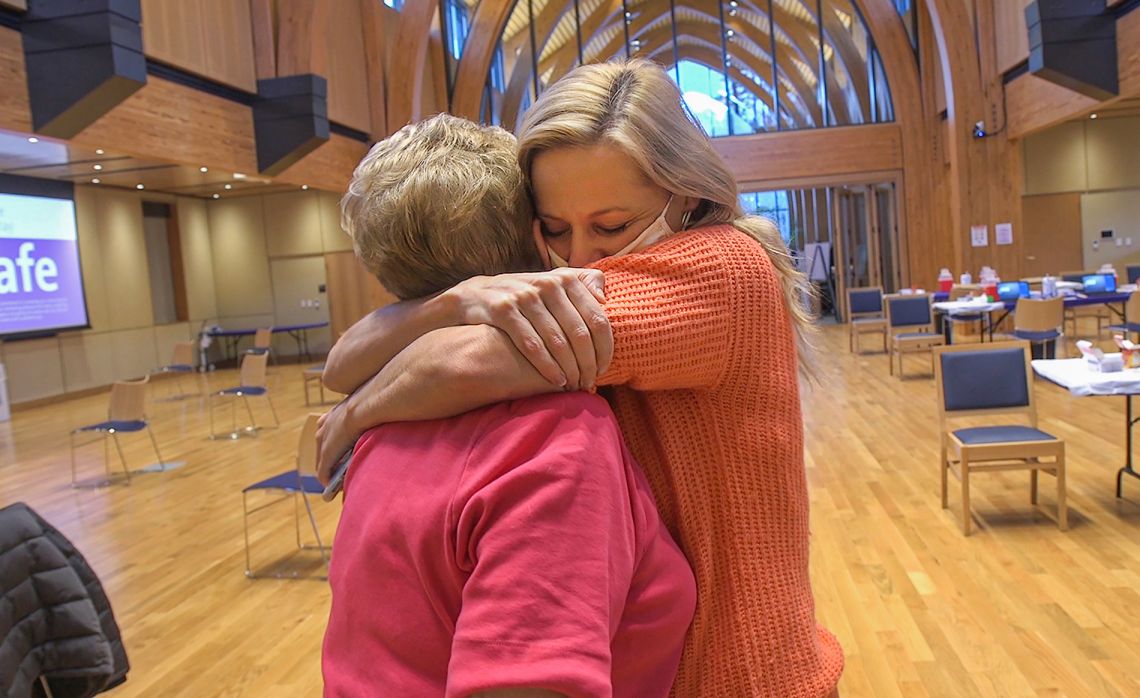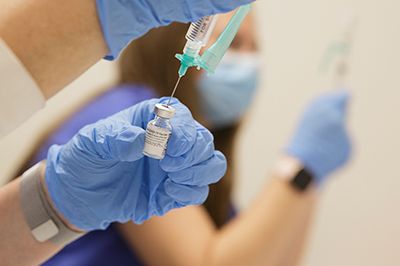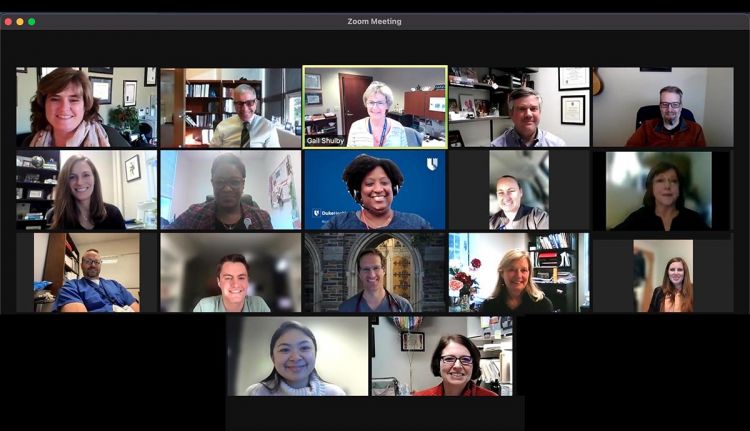One Year of COVID Vaccinations: Effort One of the Largest Partnerships Between University, Health System
A year after vaccinations against COVID-19 became available, Duke leaders reflect on collaboration on staff and community vaccination locations

Nearly 161,000 people became fully vaccinated against COVID-19 in 2021 thanks to Duke. In fact, the first dose given to the public in North Carolina was administered at Karsh Alumni and Visitors Center. What appeared on the outside as a well-oiled machine was the result of team members from across the Duke University Health System (DUHS) and Duke University working together to make this life-saving medication available.
“When you consider the breadth and the scope of what was required to stand up these vaccination sites, it was the one of the largest collaborations between the health system and the university in their existence,” said Kyle Cavanaugh, vice president, administration, and emergency coordinator for Duke University. “I remain in awe of the level of cooperation, engagement, teamwork and support.”
Finding a location
In anticipation of vaccines being approved for emergency use authorization, the COVID-19 Vaccination Work Group was formed. When COVID vaccinations first became available in December 2020, only healthcare workers were eligible. But as the criteria grew by pre-existing condition and age group, it became clear that large spaces were needed to support increased volume. The right location needed to accommodate check-in, vaccination and the 15-minute recovery period.
 The Pfizer vaccine required refrigeration. And parking needed to be nearby. Bryan Mallory, MHA, vice president of ambulatory care services at Duke University Hospital (DUH), said the minute he and the team toured Karsh, they knew it would work.
The Pfizer vaccine required refrigeration. And parking needed to be nearby. Bryan Mallory, MHA, vice president of ambulatory care services at Duke University Hospital (DUH), said the minute he and the team toured Karsh, they knew it would work.
“It was set up in less than one week and became our largest volume site,” Mallory said.
He’s grateful to Scott Greenwood, associate vice president for alumni engagement and development, and Claudia Attarian, senior director of alumni relations and visitor services, for making Karsh available and for troubleshooting when any problems arose.
“Karsh was the largest early voting site and then it became the largest vaccination site in Durham County,” Greenwood said. “We’re saving democracy and health. And it came at a time when life was out of control, and you had a sense of helplessness. But this gave us the opportunity to make a difference.”
“We are so appreciative of the health system folks putting themselves on the line every day and we wanted to support them,” said Attarian. “It was a really important partnership. It gave you hope.”
Scenes from the front lines
Chantal Howard, interim chief nursing officer, led clinical operations for community vaccination. Multiple members of her team including, Janice Frohman, Dawn Craft, Eugenia Johnson, Samantha Rimmer and Marci Leifson, helped stand up the vaccination site at Karsh as well as other sites throughout the community.
“This was an incredible collaboration between the university, clinicians and our Vice President for Continuous Improvement Heather Marstiller and her improvement coaches to create standard work and efficiency, allowing us to vaccinate as many as 1,000 patients a day,” said Howard.
 Frohman and Craft said the experience led to bittersweet moments.
Frohman and Craft said the experience led to bittersweet moments.
“As we were closing Karsh each night, people who were not eligible yet would knock on the door and ask if we could vaccinate them,” said Craft, MSN, RN, NEA-BC, clinical operations director of ambulatory care at DUH. “We were beholden to when the state said people were eligible and we felt horrible having to turn people away.”
“People who were eligible would sometimes get tearful because getting vaccinated meant they could see their family,” said Frohman, MSN, RN, NEA-BC, clinical operations director of ambulatory care at DUH.
Frohman and Craft were also struck by the number of volunteers who supported operations, especially university students who greeted the community, directed the flow of people as they checked into their appointments and staffed the observation area.
“People really wanted to help and were volunteering out of the goodness of their hearts,” said Craft.
Those volunteers included musicians who played in Karsh’s observation area and who were identified by John Brown, vice provost for the arts at Duke University.
Vaccinating staff and students
Volunteers continued to lend a hand as a new location was sought to vaccinate all health system team members and all university students. Frank DeMarco, MSN, RN, NEA-BC, associate chief nursing officer for DUH emergency services, patient flow and radiology, led the implementation of vaccinations for health system team members.
As more team members became eligible, different locations were utilized, including the Searle Center, Trent Semans and Duke Medical Pavilion. And then through a partnership with Duke University Athletics, Blue Devil Tower became available.
“Duke has a reputation that we will figure it out and make it happen to support our team and their needs,” DeMarco said. “And that’s exactly what we did.”
The teams involved included nursing, hospital administration, environmental services, Duke Health Technology Solutions, engineering, facilities, pharmacy, athletics, alumni affairs, marketing and communications, volunteer services, Duke police, student affairs, Employee Occupational Health and Wellness, parking and transportation, IT, case management, Patient Revenue Management Organization, Duke Health access services and performance services.
“There was a huge team involved and everyone leaned in to support the initiative while in addition to performing their primary job. This was an additional responsibility,” said DeMarco. “And I never heard anyone say, ‘I can’t do this,’ ‘ask someone else’ or ‘I’m too busy.’ People worked around the clock to assure the vaccine was available for our staff.”